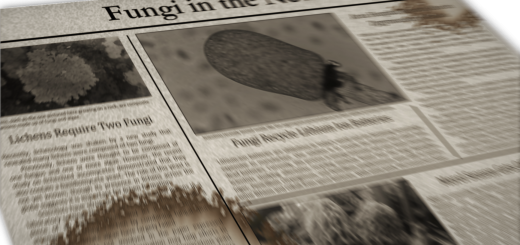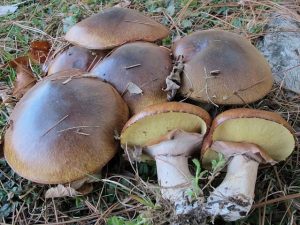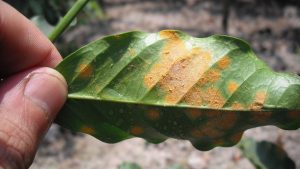#062: Overview of Lichens, Part 1: Biology and Morphology
Lichens are composite organisms made up of two mutualistic, unrelated species: a photosynthetic organism and a fungus. I find that most people don’t really understand what lichens are, and that’s not surprising, considering the definition above. OK, so we’re all familiar with lichens: the green/grey/orange/brown crusts that form on sidewalks/trees/rocks/etc. But what, exactly, are they? Most people would probably classify them as plants or, more specifically, as mosses. This would seem reasonable, as they are often found growing alongside mosses and in other similar habitats. However, this is not the case at all. Lichens are actually composed of two or more separate species growing together as one organism. This unusual type of organism is known as a “composite organism.” Lichens always include one fungal partner (the mycobiont) and at least one photosynthetic partner (the photopiont). The photobiont can be a green alga (kingdom Plantae) or a cyanobacterium (a.k.a. blue-green alga, kingdom Eubacteria). Lichens often include both a green alga and a cyanobacterium as partners. This means that lichens can be composed of organisms from up to three different kingdoms!
Although lichens have a wide variety of different growth patterns and shapes, they can be roughly grouped into three categories: crustose, foliose, and fruticose. The fungus is the dominant partner in the relationship, so it provides a majority of the structure. Crustose lichens look like crusts that cover their substrate. They have an outer surface but their underside is firmly attached to their substrate. These lichens are divided into three layers: an outer cortex, inner algal layer, and lower medulla. The cortex is composed of densely-packed fungal hyphae. These hyphae protect the photobiont cells from predation and excessive sunlight. Some lichens have a pigmented cortex for extra protection against bright light. In some cases, this masks the color of the photobiont. Some lichens have black dots on their cortex that house cyanobacteria. The algal layer is composed of loosely-packed fungal hyphae and algal cells. This layer is loose so that fresh air can easily circulate. If the cortex is not pigmented, the lichen’s color comes from the algal layer. Dry lichens tend to be grayish, but hydrated lichens become bright green (with green algae) or dark brown (with cyanobacteria). The medulla is composed of fungal hyphae that attach the lichen to the substrate. There are so many points of attachment that these lichens are almost impossible to separate from their substrate.
Foliose lichens are so called because they look roughly like leaves or lettuce and have both an upper and a lower surface. These lichens have four layers: a cortex, algal layer, medulla, and lower cortex. The cortex and algal layer are the same as above. In the medulla, the fungal hyphae connect the algal layer to the lower cortex. The lower cortex is made of densely-paced fungal hyphae, like the upper cortex. The lower cortex also attaches the lichen to its substrate, though in fewer places than in crustose lichens. This allows the lobes to lift off the substrate and gives the lichen its leaf-like morphology. Fruticose lichens look shrub-like and are attached to their substrate from a central point, like a tree. The brances of fruticose lichens are circular and surrounded by the cortex. Beneath the cortex is the algal layer, followed by the medulla. At the center of each “branch” is the central core, which is composed of hyphae that help support the rest of the lichen. These lichens often dangle from trees, but occasionally grow up from the ground. Lichens, like other fungi, often do not stick to these morphological groups and you can find many intermediate forms. Although lichens have multiple origins, they all have a similar, layered structure, which demonstrates a remarkable degree of convergent evolution.
Composite organisms like lichens are wonderful examples of symbiosis. Symbiosis, in case you’ve forgotten, is a situation in which two species live and interact closely with one another. There are a number of types of symbiosis, including mutualism (both organisms benefit), parasitism (one organism benefits at the other’s expense), and commensalism (one organism benefits while the other is unaffected). Lichens are usually classified as a mutualism, but the precise interaction between mycobiont and photobiont is still debated. Some argue that the photobiont has been “enslaved” by the fungus, which suggests a parasitic relationship. Fungal hyphae do penetrate and kill algal cells, just like a parasitic fungus. In order to sustain the lichen, the rate at which algal cells are killed is about equal to the rate at which the algal cells divide. This situation is sometimes described as a “controlled parasitism.” The lichenologist Trevor Goward described lichens as “fungi that have discovered agriculture,” perhaps suggesting a relationship somewhere between parasitic and mutualistic (maybe commensalistic). I would say that the relationship is mutualistic because the lichen is able to colonize areas that are inhospitable to either organism alone, thus benefiting both organisms.
As a composite organism, lichens have a problem reproducing: in order to grow new individuals, the lichen needs to spread both the mycobiont and photobiont. The simplest type of reproduction is vegetative, where a piece of the lichen breaks off and colonizes a new area. Lichens have also devised two ways to package fungal and algal cells together: isidia and soredia. Isidia are tiny, cylindrical extensions of the lichen that contain bits of cortex, algae, and medulla. They can easily break off and be spread to new areas. Soredia are specialized structures that contain an algal cell wrapped in fungal hyphae. They are wind-disperersed from specialized structures found on the surface of the lichen. The fungus can also reproduce sexually, but this does not bring the algal partner along. In order to form a new lichen, the sexual spores must find a suitable partner where they land. The lichen partnership has evolved multiple times, so some “lichenized” fungi produce ascospores while others produce basidiospores. Most lichenized fungi, however, are ascomycetes. Sexual spores are produced in special structures that often look very different from the rest of the lichen. At this point you may be wondering how you name a composite organism like a lichen. As it turns out, you just use the name of the fungus. This is due to the fact that the fungus is never found without the photobiont, while the photobiont is often found without the fungus.
Lichens are such strange and fascinating organisms that I can’t just devote one day to them. Come back next week to read about the ecology and impact of lichens!
See Further:
http://www.fs.fed.us/wildflowers/beauty/lichens/
http://www.earthlife.net/lichens/intro.html#2
http://www.ucmp.berkeley.edu/fungi/lichens/lichens.html








![#011: Characteristics of Kingdom Fungi [Archived]](https://www.fungusfactfriday.com/wp-content/themes/hueman/assets/front/img/thumb-small-empty.png)



3 Responses
[…] may be placed into the other morphological groups that I have described previously as well as all lichenized fungi. For example, many chanterelles and corals have a mostly smooth hymenium but are not […]
[…] algae to photosynthesize and produce sugars for the fungi.2 For more on general lichen biology, see FFF#062 and FFF#063. The Reindeer Lichen fungi can pair with a variety of algal species to successfully […]
[…] about ecology or genetics. Coral fungi are often saprobic, but can also be mycorrhizal or even lichenized. Although all clubs and corals were once placed in a single family, it is clear now that this […]